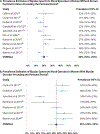Prevalence of Bipolar Disorder in Perinatal Women: A Systematic Review and Meta-Analysis
- PMID: 35830616
- PMCID: PMC10849873
- DOI: 10.4088/JCP.21r14045
Prevalence of Bipolar Disorder in Perinatal Women: A Systematic Review and Meta-Analysis
Abstract
Objective: To estimate overall prevalence of bipolar disorder (BD) and the prevalence and timing of bipolar-spectrum mood episodes in perinatal women.
Data Sources: Databases (PubMed, Scopus, PsycINFO, CINAHL, Cochrane, ClincalTrials.gov) were searched from inception to March 2020.
Study Selection: Included studies were original research in English that had (1) populations of perinatal participants (pregnant or within 12 months postpartum), aged ≥ 18 years, and (2) a screening/diagnostic tool for BD. Search terms described the population (eg, perinatal), illness (eg, bipolar disorder), and detection (eg, screen, identify).
Data Extraction: Study design data, rates, and timing of positive screens/diagnoses and mood episodes were extracted by 3 independent reviewers. Pooled prevalences were estimated using random-effects meta-analyses.
Results: Twenty-two articles were included in qualitative review and 12 in the meta-analysis. In women with no known psychiatric illness preceding the perinatal period, pooled prevalence of BD was 2.6% (95% CI, 1.2%-4.5%) and prevalence of bipolar-spectrum mood episodes (including depressed, hypomanic/manic, mixed) during pregnancy and the postpartum period was 20.1% (95% CI, 16.0%-24.5%). In women with a prior BD diagnosis, 54.9% (95% CI, 39.2%-70.2%) were found to have at least one bipolar-spectrum mood episode occurrence in the perinatal period.
Conclusions: Our review suggests that the perinatal period is associated with high rates of bipolar-spectrum mood episodes and that pregnant and postpartum women represent a special risk population. This review may help to inform clinical care recommendations, thus helping to identify those who may have.
© Copyright 2022 Physicians Postgraduate Press, Inc.
Conflict of interest statement
Figures


Comment in
-
The Pursuit to Recognize Bipolar Disorder in Pregnant and Postpartum Women.J Clin Psychiatry. 2022 Jul 13;83(5):22ed14399. doi: 10.4088/JCP.22ed14399. J Clin Psychiatry. 2022. PMID: 35830617 No abstract available.
References
-
- Cloutier M, Greene M, Guerin A, et al. The economic burden of bipolar I disorder in the United States in 2015. J Affect Disord. 2018;226:45–51. - PubMed
-
- Fernandez ME, Breen LJ, Simpson TA. Renegotiating identities: experiences of loss and recovery for women with bipolar disorder. Qual Health Res. 2014;24(7):890–900. - PubMed
-
- Perlick DA, Berk L, Kaczynski R, et al. Caregiver burden as a predictor of depression among family and friends who provide care for persons with bipolar disorder. Bipolar Disord. 2016;18(2):183–191. - PubMed

